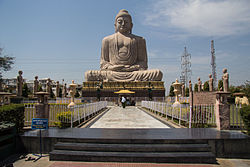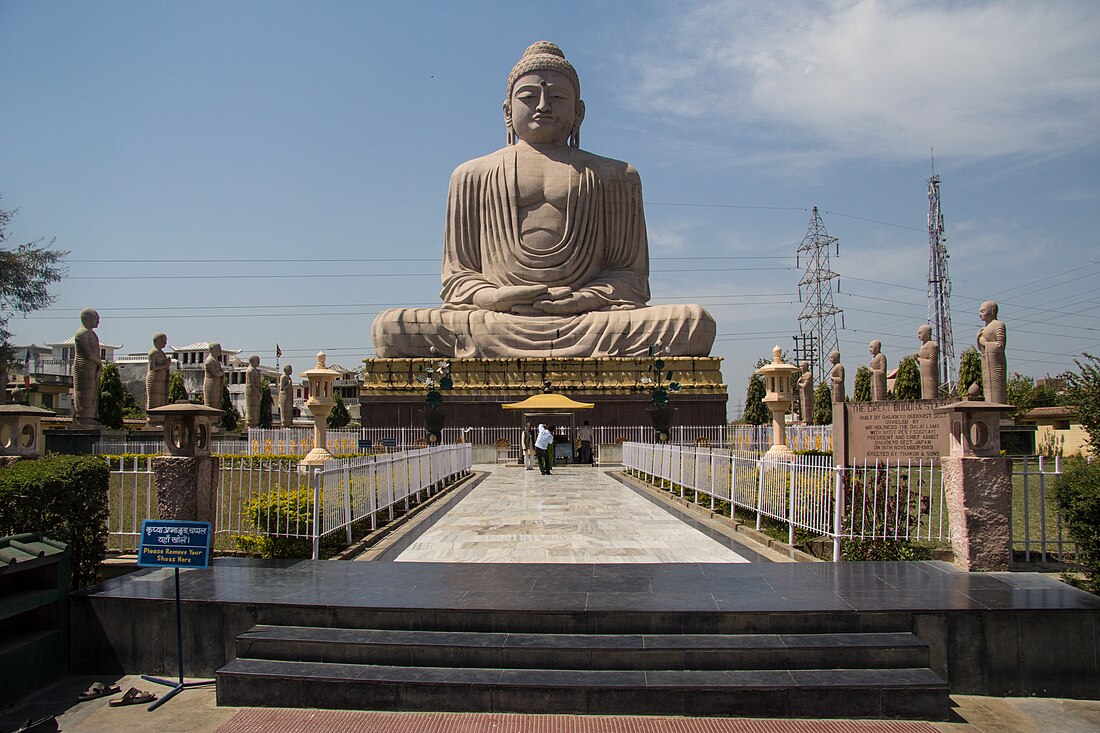Bodh Gaya
Historical city in Bihar, India From Wikipedia, the free encyclopedia
Bodh Gayā is a religious site and place of pilgrimage associated with the Mahabodhi Temple complex, situated in the Gaya district in the Indian state of Bihar. It is famous for being the place where Gautama Buddha is said to have attained enlightenment (Pali: bodhi) under what became known as the Bodhi Tree.[2] Since antiquity, Bodh Gayā has remained the object of pilgrimage and veneration, for both Hindus and Buddhists.[3] In particular, archaeological finds, including sculptures, show that the site was in use by Buddhists since the Mauryan period.[4] Bodh Gayā and the nearby regions were invaded and destroyed in the 12th century CE by Muslim Turk armies, led by Delhi Sultanate's Qutb al-Din Aibak and Bakhtiyar Khilji.
Bodh Gayā | |
|---|---|
Town | |
 | |
| Coordinates: 24.6950°N 84.9925°E | |
| Country | |
| State | Bihar |
| District | Gaya |
| Area (2015)[A 1] | |
| • City | 20.2 km2 (7.8 sq mi) |
| • Regional planning | 83.78 km2 (32.35 sq mi) |
| Population (2018) | |
| • Total | 48,184 |
| Languages | |
| • Official | Hindi |
| Time zone | UTC+5:30 (IST) |
| PIN | 824231 |
| Vehicle registration | BR-02 |
| |
For Buddhists, Bodh Gayā is the most important of the four main pilgrimage sites related to the life of Gautama Buddha,[5] the other three being Kushinagar, Lumbini, and Sarnath. In 2002, Mahabodhi Temple, located in Bodh Gayā, became a UNESCO World Heritage Site.[6]
History



Bodh Gayā is considered to be the holiest site in Buddhism.[7] Known as Uruvela in the Buddha's time, it is situated by the bank of the Lilajan River. The first temple at the site was built by Maurya Emperor Ashoka.[8]
Traditionally, it is believed that the Buddha was born in 563 BCE on the next Baisakhi purnima (second full moon in calendar years that do not themselves start during full moon) in Lumbini Nepal. As Siddhartha, he renounced his family at the age of 29 in 534 BCE,[9][10] and travelled and meditated in search of truth. After practicing self-mortification for six years at Urubela (Buddhagaya) in Gaya, he gave up that practice because it did not give him liberation. Then he discovered the Noble Eightfold Path of his own and practiced it, finally reaching enlightenment: a state of being completely free from lust (raga), hatred (dvesha) and delusion (moha).

At this point, the Buddha was abandoned by the five men who had been his companions in his earlier austerities, as all they saw was an ordinary man; mocking his well-nourished appearance, they said "Here comes the mendicant Gautama, who has turned away from asceticism. He is certainly not worth our respect." When they reminded him of his former vows, the Buddha replied, "Austerities only confuse the mind. In the exhaustion and mental stupor to which they lead, one can no longer understand the ordinary things of life, still less the truth that lies beyond the senses. I have given up extremes of either luxury or asceticism. I have discovered the Middle Way." This is explained as the path which is neither easy (his former life as a rich prince) nor hard (living in austere conditions, practicing self-denial). Hearing this, the five ascetics became the Buddha's first disciples in Deer Park, Sarnath, which is situated 13 kilometres (8.1 mi) northeast of Benares.[citation needed]
The disciples of Gautama began to visit the place during the full moon in the month of Vaisakh (April–May), as per the Hindu calendar. Over time, the place became known as Bodh Gayā, the day of enlightenment as Buddha Purnima, and the tree as the Bodhi Tree.
The history of Bodh Gayā is documented by many inscriptions and pilgrimage accounts. Foremost among these are the accounts of the Chinese pilgrims Faxian in the 5th century and Xuanzang in the 7th century. The area was at the heart of a Buddhist civilization for centuries, until it was conquered by Turkic armies in the 13th century.
The placename, Bodh Gayā, did not come into use until the 18th century CE. Historically, it was known as Uruvela, Sambodhi (![]() , Saṃ + bodhi, meaning 'Complete Enlightenment' in Ashoka's Major Rock Edict No.8),[11] Vajrasana (the 'Diamond Throne' of the Buddha) or Mahabodhi ('Great Enlightenment').[12] The main monastery of Bodh Gayā used to be called the Bodhimanda-vihāra (Pali); it is now known as the Mahabodhi Temple.
, Saṃ + bodhi, meaning 'Complete Enlightenment' in Ashoka's Major Rock Edict No.8),[11] Vajrasana (the 'Diamond Throne' of the Buddha) or Mahabodhi ('Great Enlightenment').[12] The main monastery of Bodh Gayā used to be called the Bodhimanda-vihāra (Pali); it is now known as the Mahabodhi Temple.
During the period from the 11th to 13th centuries, Bodh Gayā was under the control of local chieftains known as the Pithipatis of Bodh Gaya who were responsible for the management of the region. One of their rulers, Acarya Buddhasena, has been recorded as making a grant to Sri Lankan monks near the Mahabodhi temple.[13] During the 12th century CE, Bodh Gayā and the nearby regions were invaded and destroyed by Muslim Turk armies, led by Delhi Sultanate's Qutb al-Din Aibak and Bakhtiyar Khilji.[14]
Mahabodhi Temple

The complex, located about 110 kilometres (68 mi) from Patna, at 24°41′43″N 84°59′38″E,[15] contains the Mahabodhi Temple with the Vajrasana or "diamond throne" and the holy Bodhi tree. This tree was originally a sapling of the Sri Maha Bodhi tree in Sri Lanka, itself grown from a what is claimed to be a sapling of the original Bodhi tree.
In approximately 250 BCE, about 200 years after the Buddha attained Enlightenment, Emperor Asoka visited Bodh Gayā in order to establish a monastery and shrine on the holy site.[6]
Representations of this early temple are found at Sanchi, on the toraṇas of Stūpa I, dating from around 25 BCE, and on a relief carving from the stupa railing at Bhārhut, from the early Shunga period (c. 185 – c. 73 BCE).[16]
Other Buddhist temples

Kittisirimegha of Sri Lanka, a contemporary of Samudragupta, erected with his permission a Sanghārāma near the Mahabodhi Temple, chiefly for the use of the Singhalese monks who went to worship the Bodhi tree. The circumstances in connection with the Sanghārāma are given by Xuanzang[17][full citation needed] who gives a description of it as seen by himself. It was probably here that Buddhaghosa met the Elder Revata who persuaded him to come to Ceylon.
Several Buddhist temples and monasteries have been built by the people of Tibet, Mongolia, Nepal, Japan, Korea, Cambodia, Laos, Myanmar, Vietnam, Sikkim, Sri Lanka, Taiwan, Thailand, Bhutan and China in a wide area around the Mahabodhi Temple. These buildings reflect the architectural styles and decoration of their respective countries. The statue of the Buddha in the Chinese temple is 200 years old, and was brought from China. Japan's Nippon temple is shaped like a pagoda. The Myanmar (Burmese) temple is also pagoda-shaped and is reminiscent of Bagan. The Thai temple has a typical sloping, curved roof covered with golden tiles. Inside, the temple holds a massive bronze statue of the Buddha. Next to the Thai temple is a 25-metre (82 ft) statue of the Buddha within a garden which has existed for over 100 years.[citation needed]
Sujata Stupa
Across the Phalgu river is the Sujata Stupa, in the village of Bakraur. The stupa was dedicated to the milkmaid Sujata, who is said to have fed the Buddha milk and rice as he was sitting under a Banyan tree, ending his seven years of fasting and asceticism, and allowing him to attain illumination through the Middle Way.[18][19][20] The stupa was built in the 2nd century BCE, as confirmed by finds of black polished wares and punch-marked coins in the attending monastery.[21]
Sujata Temple
The Sujata Temple, located in Sujata Village in Bakrour near Bodhgaya, India, is a significant historical and religious site associated with the life of Siddhartha Gautama, who later became the Buddha. This temple commemorates the pivotal moment when Sujata, a village woman, offered Siddhartha a bowl of rice milk, providing him with nourishment after years of severe asceticism. This act of kindness is said to have given Siddhartha the strength to pursue the Middle Path, ultimately leading to his enlightenment. The temple stands near the banks of the Niranjana River, symbolizing the site where this transformative event took place. Architecturally, the Sujata Temple is modest yet deeply revered, attracting pilgrims and tourists alike who seek to honor the compassion of Sujata and the profound moment that it represents in Buddhist history. The surrounding village and the serene landscape add to the temple's spiritual ambiance, making it a place of contemplation and homage.
The Great Buddha Statue
An 80-foot (24 m) statue of the Buddha, known as The Great Buddha Statue is located in Bodhgaya. The unveiling and consecration of the Great Buddha Statue took place on 18 November 1989. The consecration ceremony was attended by the 14th Dalai Lama, who blessed the statue, the first great Buddha ever built in the history of India.
Under the slogan "Spread Buddha's rays to the Whole World," Daijokyo[clarification needed] spent seven years on construction of the Great Buddha Statue, mobilizing 120,000 masons in total.
Mahabodhi Temple bombings

On 7 July 2013, at around 5:15 a.m., a low intensity bomb blast took place in the Mahabodhi Temple complex. This was followed by a series of nine low intensity blasts which resulted in two monks being injured; one was Tibetan and the other Burmese. These blasts were carried out by an Islamic terrorist organization called Indian Mujahideen.[22][23] Two other bombs, one under the 80-foot statue of the Buddha and the other near Karmapa Temple were defused by the police.[24][25]
On 1 June 2018, a special National Investigation Agency (NIA) court of Patna sentenced five suspects in the case to life imprisonment.[26]
Demographics
As per the 2001 census,[27] Bodh Gaya had a population of 30,883. Males constitute 54% of the population and females 46%. Bodh Gaya has an average literacy rate of 51%, lower than the national average of 59.5%; with male literacy of 63% and female literacy of 38%. 8% of the population is under 6 years of age.
Transportation

- Buses have been introduced by the BSTDC between Patna and Bodh Gaya via Rajgir.[28]
- A special caravan service called Wonder on Wheel, between Patna and Bodh Gaya, has been introduced by the Bihar Tourism Department.[29]
- Gaya Airport is situated 7 kilometres (4 mi) from Bodh Gaya and approximately 10 kilometres (6 mi) from Gaya Junction railway station.
- Bodhgaya has restricted the use of auto rickshaws, cars and buses to make the pilgrimage site more peaceful. A permit is required for the use of cars and buses, and the only taxi available is an electric rickshaw that is mostly noiseless.
Sister cities
Bodh Gaya has one official sister city:
 Nara Prefecture, Japan[30]
Nara Prefecture, Japan[30]
See also
References
Bibliography
External links
Wikiwand in your browser!
Seamless Wikipedia browsing. On steroids.
Every time you click a link to Wikipedia, Wiktionary or Wikiquote in your browser's search results, it will show the modern Wikiwand interface.
Wikiwand extension is a five stars, simple, with minimum permission required to keep your browsing private, safe and transparent.


